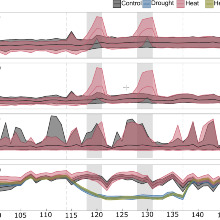Climate extremes are likely to occur more frequently in the future, including a combination of heat waves and drought. However, the responses of trees to combined stress and their post-stress recovery are not fully understood yet. Therefore, this study investigates the responses of semi-arid Pinus halepensis seedlings to moderate drought, heat and combined heat-drought stress, as well as post-stress recovery. The seedlings were grown under controlled conditions and exposed to two 4-day-long heat periods, reaching air temperature maxima of 42 °C and vapor pressure deficit (VPD) of 7 kPa. Day- and nighttime canopy gas exchange was measured and differences in shoot and root allocation of non-structural carbohydrate (NSC) compounds (soluble sugars, starch, cyclitols and carboxylic acids) assessed. Fluorescence parameters, nitrate levels, proline content and shoot water potential (ψ) provided additional indicators for stress severity and recovery performance. During the heat periods, net photosynthesis and stomatal conductance decrease immediately. This decline was modest under well-watered conditions, with transpiration and dark respiration rates remaining high and despite reductions in root NSC content, trees recovered following heat release. This was not the case in the heat-drought treatment, where stress resulted in mortality was high and the few surviving seedlings showed reduced gas exchange rates and low root NSC content, while leaf nitrate and proline remained elevated even three weeks after heat release. Shoot ψ indicated that hydraulic failure was not the reason for mortality in the heat-drought exposed seedlings. Instead, we hypothesize that low transpiration rates, which resulted in needle temperatures >47 °C during heat stress (6 °C above air temperature) have led to irreversible damage. In summary, it could be demonstrated that heat waves in combination with moderate drought can either result in increased mortality or, if the seedlings survive, in delayed recovery. This highlights the potential of an increase in heat wave temperatures to trigger forest decline in semi-arid regions.


